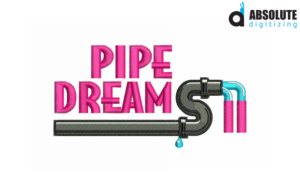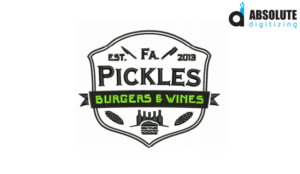Today, let us dig into the color issues encountered during and after machine embroidery digitizing. To understand these issues one must assimilate how colors are added, converted and transferred throughout machine embroidery digitizing and production process. Many new embroiderers get confused, failing to apprehend the mechanics of colors in the process.
It is obviously frustrating to see original design colors altered on embroidered products. For the same reason, let us see how color preservation is compromised during embroidery digitizing. We will also look into the possible solutions and necessary adjustments. These will help you in organizing and managing embroidery jobs systematically in the future.
Common Misconception – Digitizing Fault:
The most common misconception with novice embroiderers, regarding thread color issues, is holding the digitizer responsible. Many embroiderers tend to believe that it is due to a mistake at the digitizer’s end. Consequently, they end up requesting revisions, disputing or sometimes changing the digitizer. For the most part, it is misunderstood and misconstrued.
Honestly, there is very little a digitizer can do about color changes during the process. The problem exists due to the shortcomings of various file formats involved. The best a user can do in this situation is to develop awareness about color dynamics of the process. Only then, one can come up with measures that will actually help in combating these issues. Therefore, let us go through various formats involved in the process and how complications are incurred.
How Are Thread Colors Compromised In Machine Embroidery Digitizing?
When we define digitizing, we define it as a process where a graphic art is converted to a stitch format, which is readable by embroidery machines. It is true to an extent, but precisely speaking, the former is not true in its entirety. While the stitching details and coordinates are effectively transferred, the colors are often distorted in the process.
In an embroidery digitizing software, digitizers initially draw design areas, pretty much like a vector art software. Then stitching parameters and settings are added to it. The file created is called work file or native file. The native file is not read by embroidery machines. The digitized design has to be converted to a machine format before it can be actually brought to use for embroidering designs.
Generally, digitizers do not add colors similar to the actual design while working on it. This is done for the ease of working. Actual colors are added in the end. This allows visualizing how the end product is supposed to churn out. For running the design on the machine, it must be exported after conversion to a machine ready format.
Bone Of Contention-Embroidery Machine File Format:
Machine file formats contain stitching details as incorporated during digitizing. In fact, these details are transferred in terms of needle coordinates. These needle coordinates tell the machine when to lift, drop and stop the needle. With this being an efficient mechanism for translating stitches from file on to the product, it fails to regard coloring details. Obviously, there are provisions for color transfers but they are not efficient enough.
Commercial machine formats like DST or PES, do not have provisions for adding the colors automatically. They rose to the scene before embroidery machines had any sort of graphical capability. Consequently, it is assumed that the embroiderer will have the order of the colors. Hence, it is taken for granted that threads will be manually programmed for running appropriate thread during each run. Though some home embroidery machines have made things relatively simplified, the aforementioned assumption from the machine manufacturers remains constant.
The color issue arises when a design is saved in these machine formats after digitizing. A good digitizing software will try its best to convert colors during digitizing to the closest colors available in the chosen format. As mentioned previously, the conversion process is not very efficient. This implies that if you have chosen a specific variant of the red color, upon conversion, its integrity will not be entirely retained. In other words, if the color is not available in machine format, it will be swapped by the closest matching color.
When opened for embroidering, it will definitely be different from the original color chosen during digitizing. The problem intensifies when the native file is converted to a commercial format. Here, worsening the things, the color scheme is almost entirely lost. They only display default colors built into the file format. It must be clear by now, that there is very less that can be done at the end of embroidery digitizer. Irrespective of how colors are added during embroidery digitizing, these issues will still be there.
Solving Color Issues During Machine Embroidery Digitizing:
Solving these issues require the manual approach. Unfortunately, there is no direct method which automatically set things straight. In fact, seasoned embroiderers don’t even perceive it as a problem. They are conditioned to it and taking the required measures have become more of a routine matter for them.
The manual approach firstly requires checking the colors list. Then, threading is done accordingly. Finally, the sequencing of threads is checked while setting the needles before starting the production process. The manual approach asks for storing parallel data for each embroidery job. This is either done by saving the original artwork or storing the data in a catalog software. This obviously complicates the process but as stated before, there is no alternative.
As of now, storing information is a must. The good thing is that there are smarter solutions for managing information storage. Many home embroidery machines, have in-built cataloging features in their software. If that is not available, a third-party software can be integrated.
A much better way to go about is to keep a journal of your machine embroidery jobs. An additional benefit of having a smart storage mechanism, that apart from colors, you can also store additional run details.
The more effort you put in documenting these jobs, the easier it will be for you in the future. Rather than putting the entire blame on a machine embroidery digitizing service, it is an effort that has to be made at the end of the embroiderer.
For professional custom embroidery digitizing experience, feel free to reach out to us. We have been in the industry for the last 15 years and have some of the finest minds and hands around. Our amazing cheap digitizing services only costs $1/ 1000 stitches. For a standard delivery, all orders are prepared, reviewed and delivered in less than a day. Download our mobile apps for iPhone and android or get a quote here.



